Chapter 11 Chinese and Korean Art before 1279 – Flashcards
Unlock all answers in this set
Unlock answersquestion
Terra-Cotta
answer
A clay-based unglazed or glazed ceramic, where the fired body is porous.
question
Jade
answer
A green ornamental rock featured prominently in Asian art.
question
Cong
answer
A form of ancient Chinese Jade artifact. (used in ceramics)
question
Taotie
answer
-One of the 4 evil fiends in Chinese Mythology. -A motif commonly found on Chinese ritual bronze vessels.
question
Piece-Mold Casting
answer
Process of bronze casting using a clay mold that is divided into sections, fired, and then reassembled for casting.
question
Oracle Bones
answer
Pieces of ox scapula or turtle plastron which were used for pyromancy
question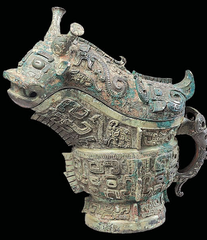
Guang

answer
A particular shape used in Chinese art for vessels
question
Fang-Ding
answer
A square or rectangular vessel with four legs and is an example of ritual bronze made during the Shang dynasty
question
Carillon
answer
a set of bells in a tower, played by a keyboard or my an automatic mechanism similar to a piano roll.
question
Pictographs
answer
Pictorial Symbol for a word or phrase
question
Ideographs
answer
A written character symbolizing the idea of a thing without indicating the sounds used to say it, e.g., numerals and Chinese characters..
question
Radical
answer
A graphical component of a Chinese character under which the character is traditionally listed in a Chinese dictionary
question
Phonetic
answer
(of a system of writing) having a direct correspondence between symbols and sounds.
question
Bracketing
answer
A unique structural element of interlocking wooden brackets
question
Handscroll
answer
A long narrow scroll for displaying a series of scenes in East Asian painting and calligraph.
question
Calligraphy
answer
Calligraphy is a visual art related to writing.
question
running/semi cursive style
answer
Cursive style of Chinese characters.
question
Pagoda
answer
a Hindu or Buddhist temple or sacred building, typically a many-tiered tower in India and East-Asia
question
Scroll Paintings
answer
A painting on a scroll in Asian traditions
question
Li
answer
The underlying reason and order of nature as reflected in its organic forms.
question
Qi
answer
Believed to be a vital force forming part of any living thing
question
Guan Ware
answer
High-status stonewares, whose surface decoration relied heavily on crackled glaze, randomly crazed by a network of crack lines in the glaze.
question
Celadon
answer
a grey-green glaze used on pottery.
question
Qin Dynasty
answer
the first dynasty of Imperial China, lasting from 221 to 206 BC.
question
Daoism
answer
a Chinese philosophy advocating humility and religious piety.
question
Confucianism
answer
a system of philosophical and ethical teachings.
question
5 Constant Relationships
answer
The relationship between -Parent and Child -Husband and Wife -Elder sibling and Junior Sibling -Elder Friend and Junior friend -Ruler and Subject
question
Tang Dynasty
answer
The greatest imperial dynasty in ancient Chinese history. It was a golden age of reform and cultural advancement (618-907 CE)
question
Amitabha
answer
The buddha of infinite light.
question
Nanchan Temple
answer
A Buddhist temple located near the town of Doucun on Wutaishan, Shanxi Province, China, built in 782 CE during China's Tang Dynasty.
question
Seokguram
answer
A hermitage and part of the Bulguksa temple complex. Located east of the temple on Mt. Tohamsan, in Gyeongju, South Korea.
question
Neolithic Cultures
answer
-Agriculture based on rice and millet arose independently before 5000 BCE; knowledge of near eastern grains followed about 2000 years later -Vigorous emergence of towns and cities in the Neolithic period.
question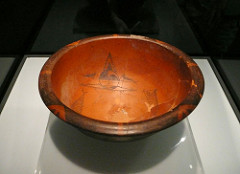
Bowl, From Banpo, near Xi'an, Shaanxi. 5000-4000 BCE. Painted Pottery, Height 7".

answer
-Shallow bowl with turned-out rim found near yellow river. -pair of stylized fish with human faces between
question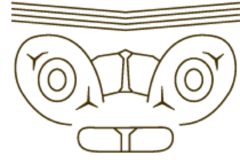
Line art drawing of mask motif from Cong Tube

answer
•Large, round eyes •Flat nose •Rectangular mouth •Meaning open to interpretation: supernatural being, deity or dead ancestor?
question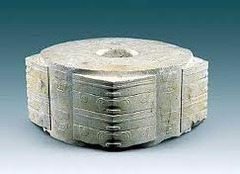
Cong. From Tomb 12 of Fanshan. China. 3600-2000 BCE. Jade, height approx. 3.4", width approx. 6.9."

answer
•Cylindrical tube encased in rectangular block •Found near buried human remains with other jade objects •Technical sophistication evident in refinement and virtuosity of objects
question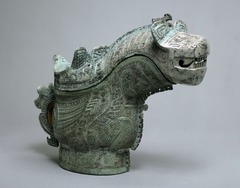
Covered Ritual Wine-Pouring Vessel (Guang) with Tiger and Owl Décor. Shang dynasty, 13th century BCE. Cast bronze, height with cover 9 3?4", width including handle 12 3/8".

answer
• Bronze Age ritual pouring vessel in animal forms • Head and body of tiger, rear portion/cover of owl • Geometric decoration combined with suggestive zoomorphic forms • Sense of mystery may correspond to Shang attitude toward supernatural Piece-mold casting
question
Set of Bells. From the tomb of Marquis Yi of Zeng, Suixian, Hubei. Zhou dynasty, 433 BCE. Bronze, with bronze and timber frame, frame height 9', length 25'. Hubei Provincial Museum, Wuhan.
answer
• Carillon of 65 bronze pieces, mostly bells • Each bell sounds two tones, one when struck at center, another when struck at the edge • Lost-wax casting
question
Ceramic Soldiers. From the mausoleum of Emperor Shihuangdi, Lintong, Shaanxi. Qin dynasty, c. 210 BCE. Earthenware, life-size.
answer
•Modeled from clay with individual faces and detailed uniforms and armor and then fired •Tomb's architects tried to match the human world as known to the Qin •Qin established central bureaucracy, divided country into provinces and prefectures, standardized writing and coinage, built roads to link the country with the capital, and battlements were connected to form the Great Wall.
question
Han Empire, 202 BCE-220 CE
answer
•Opening of the Silk Road: land route linking China by trade all the way to Rome •Philosophical ideals of Daoism and Confucianism became central to Chinese thought •Confucianism emphasizes propriety, deference, duty, and self-discipline •Daoism emphasizes individualism, nonconformity, and a return to
question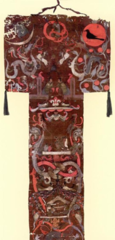
Painted Banner. From the tomb of the Marquess of Dai, Mawangdui, Changsha, Hunan. Han dynasty, c. 160 BCE. Colors on silk, height 6' 8 1?2". Hunan Provincial Museum.

answer
•Illustrates mythocentric worldview with scenes representing three levels of the universe—heaven, earth, underworld—with portrait of the deceased •Heavenly realm at top in the crossbar •Guarded gate between heaven and vertical stem, which is divided in two with bi •Above the bi is first stage of heavenly realm (deceased is welcomed by kneeling attendants) •Earthly world and underworld beneath the bi •Ritual bronze vessels with food and drink for the deceased •Fish and strange creatures inhabit underworld
question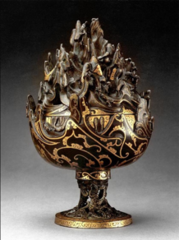
Incense burner. From the tomb of Prince Liu Sheng, Mancheng, Hebei. Han dynasty, 113 BCE. Bronze with gold inlay, height 10 1?2". Hebei Provincial Museum, Shijiazhuang.

answer
•Illustrated with Daoist legend of the Land of Immortals in the Eastern Sea •Gold inlay outlines the stylized waves of the sea around the bowl •Mountainous island above waves, crowded with birds, animals, and the immortals cast in bronze with inlaid gold highlights.
question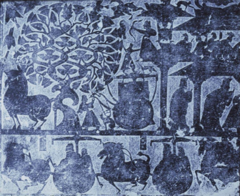
A Reception in the Palace. Detail from a rubbing of a stone relief in the Wu family shrine (Wulliangci). Jiaxing, Shandong. Han dynasty, 151 CE. 27 1?2" x 66 1?2".

answer
•From low relief stone carving meant to teach Confucian themes such as respect for the emperor, filial piety, and wifely devotion •Also contains Daoist motifs and figures from traditional myths and legends •Characteristic synchronism of Han art •Focus on human realm and human behavior, rather than supernatural creatures and divine beings •Conveys importance of emperor as holder of mandate of Heaven
question
Tomb Model of a House and Tower. From Tomb 6, Baizhuang, Henan Province. Eastern Han dynasty, 1st century CE. Painted earthenware, height of main house 6'3 1?2"; height of tower 4'2 1?2". Henan Museum.
answer
•Intended to house the dead in the afterlife •Multistory house with livestock on ground floor and people living in upper stories •Bracketing system to support wide eaves of tiled roofs—became standard element of east Asian architecture (domestic as well as temples and palaces) •Elaborate painting on model shows structural features such as posts and lintels



